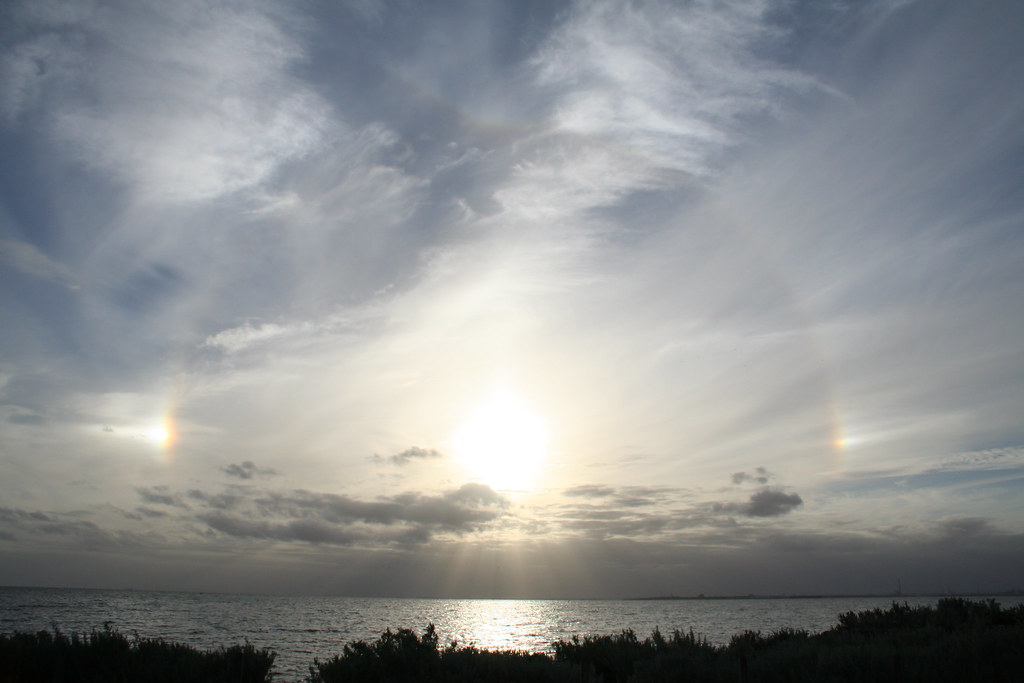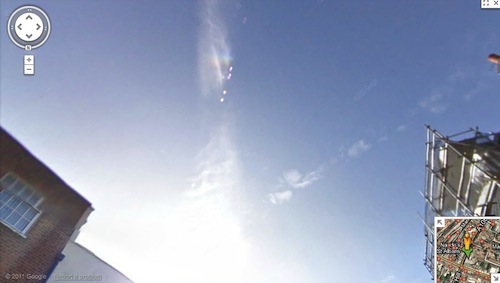I mentioned Goldfield, Nevada recently. There I noticed a street called Sundog Avenue that looked like the kind of place where one could experience a sundog in person. Then I tucked the thought away for a few days until I had more time to explore it.
A sundog describes a specific atmospheric condition that allows a bright spot of light to appear on both sides of the sun. Some people call it a mock sun. Scientifically it’s a parhelion which derives from the Greek, “beside the sun.” Maybe it’s easier to demonstrate visually:

This image has sundogs — the two bright spots on the left and right — plus a halo. No wonder the ancients sometimes interpreted this phenomenon as an omen or a sign from God. They’re pretty freaky. The Weather World 2010 Project provides a succinct explanation:
“Sundogs form as sunlight is refracted by hexagonal plate-like ice crystals with diameters larger than 30 micrometers and their flat faces horizontally oriented. Sundogs are visible when the sun is near the horizon and on the same horizontal plane as the observer and the ice crystals. As sunlight passes through the ice crystals, it is bent by 22 degrees before reaching our eyes, much like what happens with 22 degree halos. This bending of light results in the formation of a sundog. The difference between sundogs and halos is the preferential orientation of the ice crystals through which the light passes before reaching our eyes. If the hexagonal crystals are oriented with their flat faces horizontal, a sundog is observed. If the hexagonal crystals are randomly oriented, a halo is observed.”
Etymology
I understand the term parhelion because it makes perfect sense. The etymology of sundog is a bit more shrouded in mystery. Most sources don’t seem to know much more than it’s “obscure.” However, I did find a book published all the way back in 1882 that took a stab at it. I consulted Folk-etymology: A Dictionary of Verbal Corruptions. It’s “the phenomenon of false suns which sometimes attend or dog the true when seen through a mist… dog here is no doubt the same word as dag, dew or mist.”
OK, if you say so, Mr. Folk-etymology Dictionary. I have no means to confirm that interpretation. Thus, feel free to accept or reject that claim, or even create one of your own.
A Possible Recording
Google Street View may have also captured a sundog in the United Kingdom.

I wish I could take credit for this find but it’s not mine. It comes from a flickr discussion group on sundogs and related phenomena. I took a screen grab because it will disappear the next time Google refreshes its imagery outside of London. It’s still there as of October 2011 when I published this post. Go ahead and ponder it further if you like.
Sundog Used in Place Names
Curiosity gnawed at me. So I decided to see if I could find any sundog place names anywhere. I got positive results in the US Board of Geographic Names database and Natural Resources Canada – Geographical Names Canada database. However the pickings were slim. I also looked in Australia and the UK where I found nothing.
- Little Sundog Lake and Sundog Lake attach to each other via a stream in Michigan’s Upper Peninsula
- Sundog Mine, Nevada
- Sun Number Three P Sundog Number Two Mine, Fremont Co., Wyoming
- Sundog Creek, Northwest Territories, Canada
I had much better luck finding streets named after sundogs. I’m sure there are many others because I found these without too much difficulty and I stopped when I got tired of searching. These tend to be located in wide-open spaces where sundogs would be easier to spot, as one would expect.

Leave a Reply